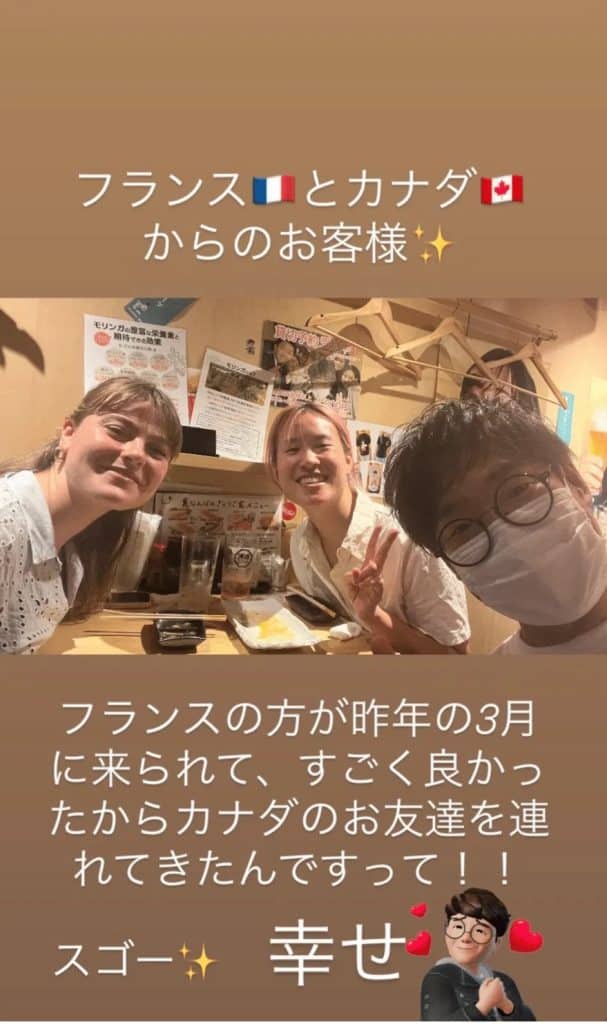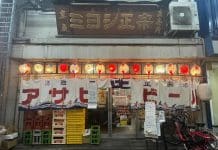Table of Contents
Introduction
In a small alleyway away from the hustle and bustle of the Namba district lies Uranamba gyōzaya. A few tables and delicious gyoza to delight your taste buds.

Ura Namba Gyōzaya 北新地ぎょうざ家 裏なんば店
Map: 3-7 Nanbasennichimae, Chuo Ward, Osaka, 542-0075. Tel: 06-6684-9900. Open: 18-23:00. Instagram: gyoza_urananba.
As night falls on Osaka and the Namba district becomes even livelier than during the day, the Uranamba gyōza bar lights up. From the dark alleyway, you can make out the place by the sign with a smiling pig on it.

A sign outside displays the gyoza to make our mouths water.
Inside, there are only ten seats, so it’s best to come in a small group! Seats are scarce. “A table for two, please,” I asked the owner.
It wasn’t my first time here. Having already fallen in love with it the first time, I decided to bring a Canadian friend to introduce her to it. She loves gyōza, so she’ll be in heaven!
Morimoto-san’s Restaurant
Morimoto san welcomes us with a smile. Also known as Morimon or Morinin, he is both the manager and waiter of this small, intimate, yet highly regarded place.
The chef explains that he opened his restaurant in July 2020, in the midst of the COVID-19 crisis. “At the time, COVID-19 was spreading around the world and we nearly went bankrupt shortly after launching. ” However, through hard work and perseverance, as well as a strong social media presence, he managed to get his business off the ground.
Thanks to word of mouth, Morimoto san has gained supporters and turned his small restaurant into a popular place where people come to enjoy good food.

Quality Service
For Morimoto-san, service and product quality are a priority. “As an izakaya bar specializing in gyoza, I hope that customers will enjoy delicious gyoza while savoring excellent drinks,” he tells me.
He adds, “I work hard because I want to see smiles on everyone’s faces as they enjoy these delicious dishes.” «
Keen to introduce people to his gyoza, Morimoto-san offers a menu in Japanese and English. He comes back to us with his phone to translate what he’s saying: here, everything is homemade, using local, high-quality ingredients. He’s keen to introduce us to his specialties. Having come on an empty stomach to taste his famous gyoza, we can’t wait! It’s going to be a feast of dishes.

But where do gyōza come from ?
Although gyōza are part of Japanese culinary culture, they were originally a Chinese dish called “jiaozi” and prepared in northern China. Gradually, the product spread throughout Asia. When it arrived in Japan, the original recipe was adapted to incorporate specific cooking techniques and ingredients based on local resources.
For example, in some regions, the initial preparation includes light frying followed by steaming, creating a harmonious combination of crispy texture and soft interior.
Gyōza became a symbol of the alliance between tradition and modernity in the gastronomic field.

Nine Varieties For Nine Pleasures
The Uranamba gyōza bar offers nine varieties of products.
- Classic gyōza, for the more conservative
- Garlic gyōza, for those who want to improve their gut health
- Plum and shiso gyōza, for those who want a little sweetness and bitterness
- Cheese gyōza, for those who need a little comfort and melt-in-the-mouth goodness
- Kimchi gyōza, for a boost on those cooler evenings.
- Ginger gyoza, for a boost of energy and freshness.
- Moringa gyoza, for those who want a little exoticism from vegetables.
- Pepper gyoza, for a fragrant numbing sensation on the tongue.
- And tomato gyōza, for an Italian touch on your plate.




The Surprising Moringa Gyoza
The big discovery at this gyoza restaurant is, of course, the moringa gyoza. But what exactly is this plant?
Moringa oleifera, often referred to as the “miracle tree” or “tree of life,” is a tropical plant native to northern India, now cultivated in many warm regions around the world.
All parts of this tree are used: leaves, seeds, roots, flowers, and pods. Very rich in nutrients, moringa has become an iconic plant in the fight against malnutrition in some developing countries, but also a highly prized superfood in Western countries.

This plant with a thousand virtues is rich in essential nutrients (vitamins A, B, C, E, calcium, potassium, iron, protein, etc.). It is also a powerful antioxidant and a natural anti-inflammatory. It can be used to treat joint pain. But moringa also stimulates the immune system. All the more reason to try it during the winter months!
What’s more, don’t worry about your digestion, as this plant is also beneficial for the stomach and intestines.
Morimoto san adds: “The leaves, in particular, contain more than 90 nutrients and 46 antioxidants, and are recommended by the Food and Agriculture Organization of the United Nations (FAO) to improve nutrition. Fascinated by moringa, I created moringa gyoza to spread the word about its wonderful properties!”
The Uranamba gyōza bar was the first restaurant in Japan to serve moringa gyōza. Morimoto-san is the inventor.
What to Choose for Our Taste Buds?
My friend and I decided to finish our tasting with kimchi gyōza, to give ourselves a boost as the evenings grow cooler.
For those who don’t know, kimchi is a traditional Korean dish made from cabbage, chili peppers, and lacto-fermented vegetables, which are soaked in brine for several weeks until they develop an acidic taste.
There are hundreds of varieties of kimchi made from different vegetables as the main ingredients. In Morimoto san’s version, the kimchi is cut very finely so that it fits perfectly into the Japanese dumplings.
The crispy exterior of the gyōza contrasts with the spicy interior

« Yukke »
Another discovery that made our mouths water was the dish called yukke. Thin slices of pork, streaked with mouthwatering fat, are placed on a slate. On top is an egg yolk. In small ramekins is a secret sauce with sesame and spring onion.
The first time I came, I wasn’t very comfortable with the idea of eating raw pork. But Morimoto san reassured me: he would grill this thinly sliced pork with its mouthwatering aroma right in front of us.
Using a small blowtorch, he quickly and precisely browned the meat to render the fat without overcooking it. The idea is to give it a grilled flavor without making it too crispy, so as to preserve the texture of the meat in the mouth.
Once this is done, the chef explains that we should break the egg yolk and spread it over the sizzling meat. Then, we simply dip the thin slices into the sauce to enhance the flavor of the meat. Delicious!


Hojuton pork
This dish would not be on the menu if Morimoto-san bought just any meat. Serving ordinary food to his customers is out of the question for him.
For this signature dish, the chef uses Nagasaki hojuton pork, which is carefully raised using special farming methods called SPF (Special Preservative-Free), meaning it is free of bacteria that can cause food poisoning in humans. This rare and edible “hojuton” cannot be mass-produced, making it extremely rare, expensive, and delicious.
Although raw pork is currently prohibited, hoju pork is safe enough to be eaten in sashimi or tataki. In addition, the unique smell of pork cannot be detected at all, and it is juicy and sweet.
“Hoju pork has acquired the best meat and the best flavor. Please enjoy this taste that was born from continuous attention,” writes Morimoto san on his website.
It was after visiting the production area several times that the Uranamba gyōza bar decided to develop recipes based on hojuton pork.
This pork is also used to prepare “meibutsu gyōza,” the classic gyōza offered on the menu.
Morimoto san explains his reasoning behind this choice: “Although the gyōza we serve are dumplings, I don’t think they’re just junk food; they’re also a healthy dish.”
This restaurant is the third in the Kitashinchi gyōza franchise. The representative director says he wants to take on the challenge of food waste. “We will continue to work hard so that our gyozas, which aim to solve the problem of waste in rural areas, can grow.”

The Third Kitashinchi Gyōza Restaurant
Uranamba gyōza bar is the third restaurant in the Kitashinchi franchise, which popularized the use of hotujon pork. Their dumplings have been praised as “the most delicious in Kita” by a Michelin-starred chef.
“Initially, we developed the product as a product for restaurants, mail order, and wholesale, but after development, a friend who owned the property in Kitashinchi where our first store would later be located asked us if we wanted to open our first store together, and that’s how Kitashinchi Gyoza-ya was launched,” says Managing Director Toru Machida.
The representative director says he wants to tackle the challenge of food waste by selecting the right quantities needed for the stores. “We try to sell even the least popular parts without leaving any leftovers, and we mince them into ‘Hoju 100% Pork Premium Gyoza’.”
After much trial and error, which took two full years of development, we finally created our “Premium 100% Hoju Pork Gyoza,” which we are proud to offer.
In this context, we received an invitation to join our franchise and decided to open a second, then a third restaurant. “We will continue to work hard so that our gyozas, which aim to solve the problem of waste in rural areas, can grow.”

Some Necessary Information
- Cash only
- Menu in English and Japanese
- Vegetarians welcome





















